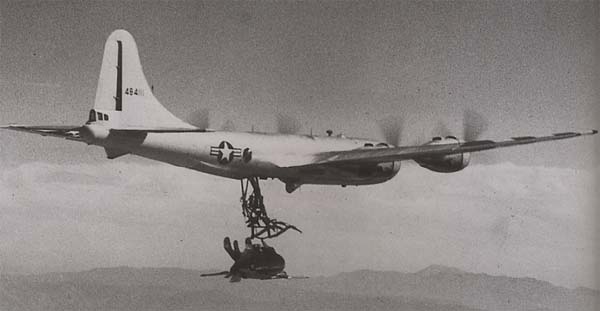
|
John A. Weeks III
Friday, January 9, 2026, 3:49:55 PM CST |
|||
| Home | Photo Tours | Rail Fan | 12 Easy Steps |
| Aviation | Spacecraft | Highways & Bridges | About The Author |

|
|
|||||||||||||||||
XF-85 — The Goblin Survivors
The US Army Air Force proved the value of strategic bombing during WWII.
The USAAF bombed Germany by day, and the British bombed by night. While
they were never able to shut down war materials production inside of
Germany, the bombing caused war material production to become very
expensive, and it required a large standing army to protect such facilities.
In Japan, strategic bombing quickly destroyed factories and industrial
centers to the point that there were very few strategic targets left in
that nation by the end of the war.
The second item that the USAAF learned is that strategic bombing can be very expensive in terms of aircraft and crew. Losses were sometimes horrific. At times, the US commanders considered shutting down the bombing program because of unsustainable losses. The key factor in the losses was that the USAAF was unable to provide fighter protection for the bombers all the way to the target. The escorts were limited in range. Once the escorts turned for home, the German Luftwaffe was ready and waiting to attack the bomber formations.

As the USAAF looked to the post war situation, they realized that the key mission was going to be delivering nuclear weapons to the interior of the Soviet Union. The long range nuclear bombers that were on the drawing board, the B-35 and B-36, would need fighter protection if they were to have any hope of reaching targets in the heavily defended Soviet Union homeland. The problem was that the new jet fighters had very high fuel consumption. They simply could not make a flight across the Arctic Ocean The solution that was developed was to carry a fighter aircraft in one of the bomb bays of the B-35 and B-36 aircraft. The B-36 had three massive bomb bays. The small jet fighter that would be carried internally actually weighed less than a nuclear bomb from the era, so it actually represented a net gain as far as fuel consumption was concerned. If a nuclear bomber was attacked, it would deploy the parasite fighter, let the fighter kill off the attacker, and then retrieve the parasite fighter through a docking and trapeze mechanism. Since the fighter would be making only short local flights, fuel was no longer an issue. The resulting fighter aircraft was the XF-85 Goblin. It was built by McDonnell Aircraft. The 5,600 pound aircraft was 14 feet 10 inches long, 8 feet 4 inches tall, and had a wingspan of 21 feet. It was powered by a single Westinghouse J34 turbojet engine. The engine put out about 3,000 pounds of thrust and weighted 1,200 pounds. It did not have an afterburner. The Goblin proved to be an excellent little aircraft. It flew well and responded well to control inputs. Its light weight compared to the power gave it excellent performance, allowing it to hit upwards of 650 miles per hour. The Goblin made a number of flights between August 23, 1948 and October 24, 1949. The XF-85 program ran into several problems. The biggest was that test pilots found it to be almost impossible to dock with the mothership after a flight. While there were some successful dockings, many of the docking attempts lead to emergency landings. The second issue is that the proposed armaments on the aircraft, 4 machine guns, would likely not be enough to handle ever newer fighter aircraft being developed by the Russians. Finally, as aerial refueling was perfected, it appeared that the problem of flying escort aircraft to the target and back may have been solved. As a result, the F-85 program was canceled, and the two prototypes were retired. XF-85 Goblins On Static Display
Note—click on the Serial Number to see a photo of each airplane.
|
|
|
Authored by John A. Weeks III, Copyright © 1996—2016, all rights reserved. For further information, contact: john@johnweeks.com
|